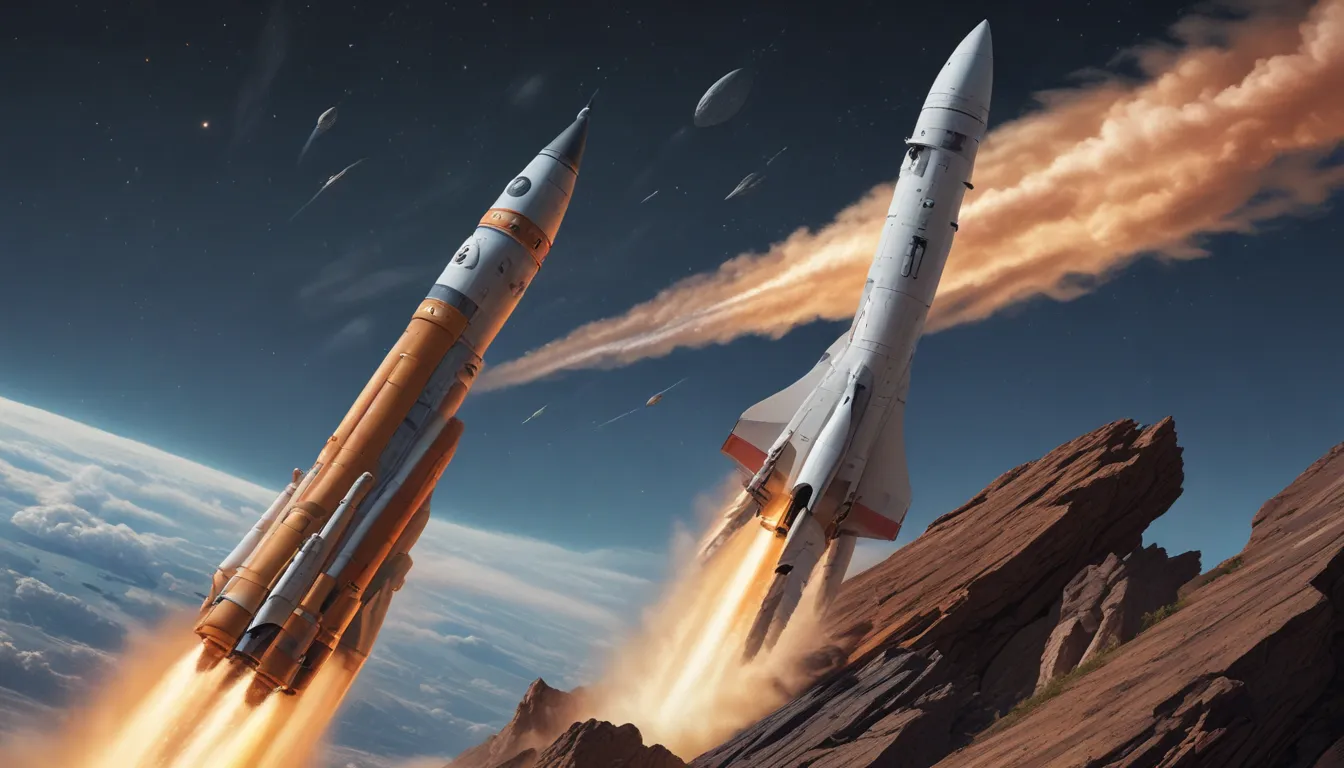A Note About Images: The images used in our articles are for illustration purposes only and may not exactly match the content. They are meant to engage readers, but the text should be relied upon for accurate information.
Have you ever gazed up at the night sky, wondering how rockets defy gravity and journey into the vast cosmos? Rockets are not merely vehicles for space exploration; they represent extraordinary feats of engineering and scientific innovation. Each rocket launch embarks on a new chapter in our quest to unravel the mysteries of the universe. From ancient origins to cutting-edge technology propelling us beyond Earth’s atmosphere, the realm of rocketry is brimming with captivating facts waiting to be discovered. Are you ready to embark on a journey through the wonders of rocketry? Let’s ignite our engines and soar through 20 amazing rocketry facts that will leave you awestruck!
Unlocking the Mysteries of Rocketry
Rocketry encompasses the design, construction, launch, and sometimes recovery of vehicles that traverse Earth’s atmosphere or embark on interstellar journeys. These awe-inspiring vehicles, known as rockets, are propelled by the expulsion of exhaust gases from rocket engines. Unlike airplanes, rockets do not rely on the surrounding air for lift and can operate even in the vacuum of space.
- Rockets have been utilized for fireworks and military purposes for centuries, long before their application in space exploration.
Tracing the Evolution of Rocketry
The evolution of rocketry from ancient times to its pivotal role in modern space exploration heralds a testament to human ingenuity and curiosity.
- The earliest documented usage of rocket technology dates back to China in the 13th century, primarily for fireworks displays and subsequently as military armaments.
- In the 20th century, rocketry experienced a significant leap forward with the development of liquid-fueled rockets, spearheaded by visionaries such as Robert H. Goddard.
Rockets: Pioneers of Space Exploration
With the dawn of space exploration, rockets have emerged as the backbone of missions venturing beyond Earth’s confines.
- The V-2 rocket, crafted by Germany during World War II, marked the first human-made object to breach the confines of space, surpassing the Kármán line in 1944.
- In 1957, the Soviet Union ushered in the space age with the launch of Sputnik 1, the inaugural artificial satellite to orbit Earth.
- The Saturn V, a creation of NASA, stands as the most potent rocket ever constructed and facilitated the Apollo missions’ voyage to the Moon.
Decoding the Mechanisms of Rockets
Grasping the fundamental principles of rocketry unravels the mysteries behind these magnificent machines as they defy gravity and journey into the cosmos.
- Rockets operate in accordance with Newton’s third law of motion: for every action, there exists an equal and opposite reaction.
- Rocket engines incinerate fuel and oxidizer to generate high-speed exhaust gases, which are expelled downward, propelling the rocket skyward.
Embracing the Future of Rockets
Innovations in rocket technology continue to push the boundaries of possibility in space exploration.
- Enterprises like SpaceX and Blue Origin are pioneering reusable rockets, aiming to drastically reduce the cost of space travel.
- NASA’s Artemis program eyes a lunar return by 2024, employing the formidable Space Launch System (SLS) rocket, emblematic of the ongoing evolution within rocketry.
Rocketry: A Cultural Phenomenon
Rockets have captivated the collective imagination, inspiring a myriad of fictional works and cultural references.
- Iconic movies such as “2001: A Space Odyssey” and “The Martian” depict the utilization of rockets in space exploration, shaping public perceptions and spurring interest in celestial travel.
- The phrase “It’s not rocket science” has become a colloquial way to convey a task that is not overly complex, underscoring rocketry’s reputation as the pinnacle of technical prowess.
Addressing the Environmental Impact of Rockets
As rocket launches burgeon in frequency, apprehensions regarding their environmental footprint escalate.
- Rocket launches can emit substantial quantities of pollutants into Earth’s atmosphere, including black carbon, contributing to global warming.
- Endeavors are underway to devise environmentally sustainable rocket fuels and technologies to mitigate these ecological repercussions.
Rocketry as a Recreational Pursuit
Beyond governmental and corporate domains, rocketry has also emerged as a prevalent hobby among enthusiasts worldwide.
- Amateur rocketry clubs span the globe, encompassing members who construct and launch their model rockets.
- High-powered rocketry, characterized by larger and more potent rockets, mandates certification and adherence to safety protocols due to heightened risks involved.
Pioneering Rocketry Achievements
Throughout history, rocketry has witnessed a myriad of milestones and records shattered as technology and ambition burgeon.
- The Falcon Heavy, operated by SpaceX, currently stands as the world’s most potent operational rocket, capable of hoisting nearly 64 metric tons into orbit.
- In a groundbreaking feat in 2020, a Japanese company successfully launched a rocket measuring a mere 9.5 inches tall, clinching the title of the smallest rocket to breach space.
Rockets: Facilitators of Satellite Deployment
Rockets play a pivotal role in positioning satellites into orbit, a task with boundless applications in contemporary existence.
- Satellites for communication, weather tracking, and Earth observation are all deployed through rockets.
- The escalating demand for satellite internet services, exemplified by SpaceX’s Starlink, hinges extensively on rocket launches to construct and perpetuate its satellite constellation.
Fostering International Space Cooperation through Rocketry
Rocketry has evolved into a realm of international collaboration, with nations pooling resources and knowledge for collective endeavors.
- The International Space Station (ISS), emblematic of international cooperation, is replenished by rockets from diverse nations.
- Collaborative missions, such as the Mars rover Perseverance launched via a United Launch Alliance Atlas V rocket, underscore the global nature of space exploration ventures.
Rocketry in the Realm of Education
Educational programs worldwide leverage rocketry to galvanize the forthcoming generation of scientists, engineers, and explorers.
- A myriad of schools and universities proffer programs and clubs centering on crafting and launching model rockets, imparting students with invaluable STEM proficiencies.
- Competitions like the Team America Rocketry Challenge (TARC) furnish students with opportunities to design, assemble, and pilot their rockets, nurturing interest in aerospace vocations.
Unveiling the Psychological Impact of Rocket Launches
Witnessing a rocket launch can elicit a profound experience, evoking a spectrum of emotions and fostering a sense of connection with the universe.
- For many individuals, observing a rocket soar skyward, en route to space, symbolizes human potential and the relentless pursuit of knowledge.
- Astronauts frequently recount the “overview effect,” a cognitive shift in awareness reported during space travel, underscoring the fragility and harmony of life on Earth.
Safeguarding Measures in Rocketry
Safety assumes paramount importance in rocketry, with stringent measures enacted to safeguard lives and property.
- Launch sites are meticulously chosen and formulated to minimize risks to inhabited regions, with exclusion zones delineated around launch pads.
- Rocket designs undergo rigorous evaluations and validations to ascertain their ability to withstand the rigors of launch and space odysseys.
The Economic Influence of Rocketry
Rocketry commands a substantial impact on the global economy, not solely through rocket manufacture and launches but also via the services they facilitate.
- The global space sector, valued in excess of $400 billion, is poised for exponential growth as space tourism and commercial spaceflight burgeon.
- Occupations in aerospace engineering, satellite communications, and cognate domains are pivotal to economies worldwide, underscoring the necessity of continued investment in rocketry.
Navigating Challenges and Controversies in Rocketry
Despite its myriad triumphs, rocketry confronts challenges, encompassing geopolitical tensions and concerns revolving around space debris.
- The militarization of space and the evolution of anti-satellite armaments underscore apprehensions regarding potential conflicts beyond Earth’s confines.
- Space debris, comprising defunct satellites, depleted rocket stages, and other detritus, poses an escalating hazard to active satellites and human space endeavors.
- Initiatives to institute international agreements and technologies for debris clearance and space traffic management are imperative in ensuring the sustainable progression of space exploration.
Embarking on a Final Expedition through the Realms of Rocketry Marvels
We’ve traversed a galaxy of extraordinary facts, each more enthralling than the last. From the nascent days of space exploration to the vanguard advancements of the present, rocketry stands as a realm of limitless wonder and infinite potential. These 20 facts scarcely scratch the surface of this expansive and intricate domain. They serve as a springboard for curiosity, urging further exploration into the science, history, and future of rocketry. Whether you harbor aspirations of becoming an astronaut, exude an enthusiasm for space, or merely find solace in gazing at the night sky, the realm of rocketry beckons with boundless opportunities for learning and discovery. So keep your gaze fixed skyward and your inquiries ceaseless, for the sky isn’t the limit; it’s merely the commencement. Let’s train our sights on the stars and our minds unbarred to the infinite possibilities that rocketry and space exploration hold in store for us.
Did you find this page enlightening?
Our unwavering pledge to present reliable and captivating content constitutes the cornerstone of our mission. Each fact featured on our site emanates from real users like you, enriching our repository with a myriad of diverse insights and information. Enforced by our devoted editors, every submission undergoes stringent review to ensure the highest standards of accuracy and authenticity. Rest assured in our commitment to quality and legitimacy as you embark on a journey of exploration and learning with us.






